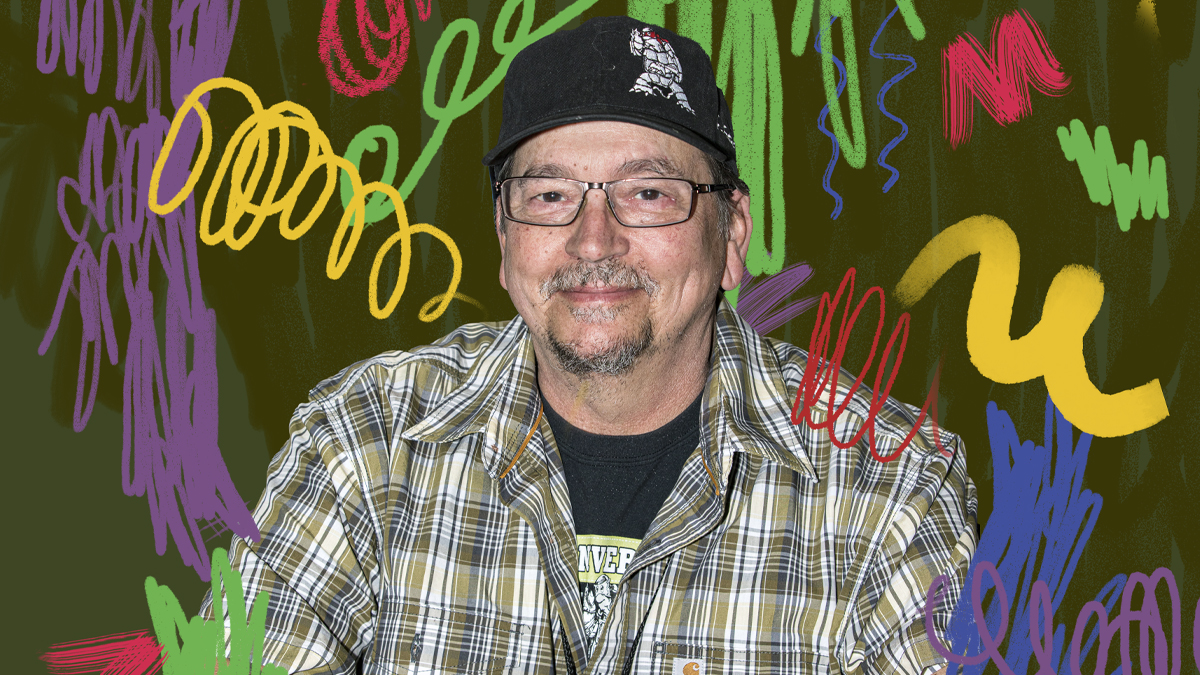Teenage Mutant Ninja Turtles: Mutant Mayhem – Kevin Eastman on the Past & Future of the Franchise
The co-creator of TMNT takes us back to their humble beginnings, gives us a little franchise history lesson, and explains how it all ties in to Teenage Mutant Ninja Turtles: Mutant Mayhem.

This article is presented by Paramount Pictures. 
Approximately 40 years after Teenage Mutant Ninja Turtles co-creators Kevin Eastman and Peter Laird first jokingly sketched a masked turtle standing upright with a pair of nunchaku strapped to its little arms, TMNT is one of the biggest franchises in the world. Leonardo, Donatello, Raphael, and Michelangelo are now veterans of not only years of comic book storytelling, multiple beloved animated series, blockbuster films, video games, countless toys, and more, but their Renaissance-inspired names are now household ones, and their adventures have delighted multiple generations of children and adults.
In short, the TMNT are a genuine pop culture institution, a status that’s only going to be further cemented with the release of Teenage Mutant Ninja Turtles: Mutant Mayhem, a breathtakingly animated new feature film with an all-star voice cast and an authentically “teenage” attitude and sense of humor.
So, naturally, TMNT co-creator Kevin Eastman would have something to say about it. You might think that after nearly four decades, Eastman would be tired of talking about his most famous creations. But when we catch up with him via Zoom, literally half the world away, as he visits Perth, Western Australia, to make an appearance at a convention, you’d never know it.
Wearing a baseball cap adorned with that original Ninja Turtle sketch, Eastman still lights up when he recounts the tale of how he and Laird first dreamed up the world’s most beloved reptiles. He’s still grateful for the fact that the pair were able to keep their creative control as their humble independent comic became a multimedia empire, a move that certainly isn’t the norm when talking about superhero success stories throughout history. But most of all, he still gets excited when talking about these characters and the expansive world they now inhabit.
A big part of that is the impending release of Mutant Mayhem, which he has no shortage of praise for, and he gets visibly animated himself when we turn our conversation toward it. It may have been the end of a long convention day for the creator when we speak, but he has plenty of time and energy to share with fans about where the Turtles have been and where they’re going next.
Can you give us a quick overview of the humble beginnings of the franchise?
Honestly, the idea of the Turtles came from such a place of passion and purity for [TMNT co-creator] Peter Laird and me. Growing up as huge fans of comics, we bonded immediately over our mutual heroes, like Jack Kirby and many others, who led us down this path of inspiration to tell our own stories. We wanted to put everything we loved about comics into an idea.
So late one night, Peter and I were working on a couple of ideas. I had this idea of a martial artist like Bruce Lee or Jackie Chan as an animal, and what would be the stupidest animal it could be? I thought of a turtle. So I did the first sketch of a turtle standing upright with a mask on and nunchaku strapped to his arms, put it on Peter’s desk, and said, “This is a Ninja Turtle. It’s going to be the next big thing” with a big laugh. So Peter did a sketch and changed some things, and we immediately said, “Well, why not a group of them?”
I did a pencil sketch: four turtles, all with different weapons in this sort of comic book cover pose, and when Peter inked it, he added the “Teenage Mutant” to the “Ninja Turtles” title that I had put on the drawing. It was laugh-out-loud-funny. We said, “This is the dumbest thing we’ve ever seen. This is the coolest thing we’ve ever seen. We love it. Let’s come up with a story that tells how these characters became the Teenage Mutant Ninja Turtles.”
We spent the next several months creating a 40-page comic that told the origin story. We took all our favorite bits from all the things we loved about all things comics and put them into this one book. We only did one book with a beginning, middle, and end because we never thought there’d be anything more than the first issue [at the time]. But we had big grins on our faces because we’d done it. We’d created our own characters and put out our first comic books with the help of some family crowdfunding to help cover the cost of the first 3000 copies. We were bound and determined we were going to be comic book storytellers.
What has given them such timeless appeal? And what makes new interpretations like Mutant Mayhem so vitally important?
Take, for example, something like Marvel’s Fantastic Four, where you have this family, both a specific family and adoptive family, a group of people that have different strengths, different powers, who could bicker and argue and have differences of opinion, but when they are bound together as one, focused as a family, they would always succeed. That was very adaptive to a school group that you’d hang out with or friends in the workplace, those kinds of things. So I think that there were a lot of familial elements. And then you combine that with characters being the heroes we always hope we’ll be when the chips are down and people, especially family and the ones we love, are counting on us to do the right thing.
And then there’s the fact that the Turtles aren’t of any specific race, creed, or color, so to speak. I love that I can be anywhere and talk to anyone of any nationality or race and ask, “Who’s your favorite Turtle and why?”… It’s the underdog factor, the hero that we all would like to be, that Peter Parker/Spider-Man aspect of “I just want to be a teenager.” It’s all those things.
We just put things that we liked into it. What we liked about ourselves… things that we wanted to see in the characters. I think that made them special to us. We weren’t writing for anybody else. We never thought anybody else would actually buy the book [laughs]. So it’s amazing to think that we’re having this conversation nearly 40 years after that first issue, and it’s still resonating in some capacity with the original fans and the newer fans that have come on board throughout the years. It’s become this fantastically humbling generational concept. It’s wonderful. I think that’s probably what I like about going to conventions, getting to meet these people.
But looking at a project like Mutant Mayhem, the people that brought this story to life grew up as fans [so] the things that they’re putting into it are things that they loved about it, or they wanted to see in it, and that got their imagination going. So when they put that same passion into the idea, it works because it’s meaningful and it feels so good.
When did you realize that you had something special on your hands?
It really did come in a series of milestones for us. The first issue of the comic came out in May of 1984. The first five episodes of the animated series ran around Christmas break in 1987. The first toys shipped in June of 1988. For us, the first milestone and probably the most important was in 1985, when we were getting orders in from distributors for issue two, and it was 15,000 copies, [12,000 more than issue one]. Peter quickly did some math, and we figured that if we could do six of these comics a year, we could pay our rent, eat, and draw comics for a living full-time. And it just continued to grow from there.
Then suddenly, we were presented with opportunities to develop a cartoon show and a toy line. We loved the idea, but we felt very protective of it because it was an idea that we owned, and being huge fans and respectful to the heroes that we followed who didn’t have the rights to control their properties, we were very careful. So we said, “We’ll do this, but on our terms, we’ll have full approval; nobody can do anything with the characters without it,” and we kept it really restricted and limited. So when [the animated series and toys were first released], we hoped for the best. But it really clicked with fans, and before we knew what we were doing, we had jumped on board this very fast-moving train, but in control of the train, at our pace, so to speak, and thrilled that we get to have the participation we wanted to with the characters.
But I sort of sum it up by… my grandmother used to send me $5 in a birthday card or Christmas card most of my life. She was watching TV one night, and the TMNT were a question on Jeopardy. And she finally felt at that point that I was successful enough and that the Turtles were popular enough that she didn’t need to send me $5 in my birthday card or at Christmas. She was very proud.
What is the one fundamental quality that is most important for each of the Turtles?
As the Turtles were designed, however naively and happily, almost accidentally, if you will, we modeled personalities in the early days based on either pop culture characters or comic characters or genres. Donatello was based on Peter Laird, he was the geekiest guy I knew, and I always thought about him when we wrote him. Raphael was the tough guy in school. I feel like it was that core [concept of] four turtles as lost orphans adopted by this incredible father figure, Splinter, even as we expanded the family to bring April O’Neil and Casey Jones in… this wonderfully adoptive family seemed to be the heart and soul.
How is Mutant Mayhem the logical evolution of that for 2023 and this generation’s TMNT fans?
It seems like every generation of the TMNT can build upon those personalities [but] it’s still built around that heart and soul family aspect. What immediately struck me about Mutant Mayhem was that the family aspect is really the core. It’s the love and appreciation. You know what they say, “You don’t always like your family, but you always love your family.” That seems very prevalent. One of the things that struck me the most about Mutant Mayhem is the dialogue and the ebb and flow of how the family talks. They overtake each other, and they’re talking at the same time, and it’s going back and forth. You can be all over the place, but you’re still on the same page, and the love is there. I think that’s the core that’s held them together throughout their entire history.
Did you know when you introduced April O’Neil in issue two that this character was going to be the human anchor of all their stories going forward?
No, and what I mean by that is, when we did issue one, we never imagined there would be an issue two. When we did issue two, we hoped it would be received well enough that we’d be able to do an issue three and more. So when we brought in April, we immediately fell in love with her as a character. We were big fans of characters like Sarah Connor [from the Terminator films] or Ellen Ripley [from the Alien movies]. So by the time we finished issue #2, we knew we wanted to keep her in the family; we felt she was a perfect, strong, kind of sisterly character that brought another perspective. She was more of a specific connector to the above-ground world, the “real world” for the Turtles, who had been underground the whole time. So it gave us a wonderful character and a plot point that we could develop further into telling bigger stories.
It’s almost like when you meet somebody new, and you already know you’re gonna be good friends. You know, even though you’ve not really known them that long, they’re going to be part of your life forever. And I feel like that’s the feeling [we had with April]. That’s the approach that we took to bringing April into the family.
What do you think of the way April is portrayed in Mutant Mayhem?
I think about so many different and wonderful creators that I’ve had the chance to work with over the years. But the importance of updating the character into a person of the here and now who makes the kinds of comments and does the kinds of things she does, it just feels fresh, alive, and modern, and it works so well.
Can you talk about Splinter’s evolution?
Peter and I, in the early days, were big fans of characters like Yoda and Mister Miyagi. It was about having a Sensei, having a parental figure that was very tough on you, but it wasn’t without love. I feel like we had that with Splinter in the early days of the TMNT when he was very protective. He was the father figure.
What about his portrayal in Mutant Mayhem?
I love how in Mutant Mayhem, they took it to even more of a protective level. Because we never completely touched on a lot of pre-Teenage Mutant Ninja Turtles history, I feel like some of the approaches they’ve taken here, it’s very reminiscent of the ways that I grew up, and I can definitely see the inspiration of, you know, “be careful, it’s a cruel world out there, be safe.” And I think it’s a very interesting character take for Jackie Chan as well. I think fans are really going to love his version of Splinter. It’s quite endearing and polite. It’s heartwarming.
We’ve never seen this many mutants in a TMNT movie before…
One of the things that has been so much fun is watching how the stories evolve and come together. One of the first licensing things that we did back in the day after the original comics was a role-playing game with Palladium Books back in 1985, which [featured templates for] all these different mutant characters that you play against or as. When we started developing the first cartoon show, we already had a wealth of material in this mutant universe that we could play with and build upon. Just about every version of the TMNT since the first cartoon has built on the ooze and the mutants. I like the fact that this movie doesn’t feature just one bad guy. Everyone gets their moment, and it’s pretty awesome. It’s called “Mutant Mayhem” for a reason.
What do you think about this voice cast?
I just love that they chose to do things like having real teenagers [voice the Turtles] and record them all together, interacting and responding to stuff, and allowing some of the improv and the organic nature of some of the conversations to ebb and flow the way that they did. It didn’t seem like, “Hey, let’s get this name because it would look good on a marquee,” it’s “Get this person into this movie because they’ll do an incredible job as this character.” Nothing felt like an afterthought; it was all done with great purpose. And it comes across. Seth Rogen’s voicing Bebop! Paul Rudd doing Mondo Gecko! Ice Cube as Superfly! I’m looking at this stuff going, “Oh my god, this is so awesome. It’s really funny. This is really good stuff.” I was watching some of the scenes with my jaw hanging open. It’s perfect. It’s great.
How would you describe the animation style?
It’s a beautifully, wonderfully organic approach to the characters’ shape and how they move in depth in so many of the scenes. But what struck me, in particular, was how everything had weight and balance, and it felt grounded. You can stylize [animation] in a way that can be distracting or pull away from the story that you’re trying to tell, but everything that they’ve done with the style furthers the story. What [director and co-writer] Jeff did so well is really put the focus on the story and the moments and the beats. It has substance. It just felt good. It isn’t distracting. It keeps you engaged, and you forget everything else. All you care about is where the director is taking us. It’s fantastic.
Teenage Mutant Ninja Turtles: Mutant Mayhem is out in theaters on August 2.
